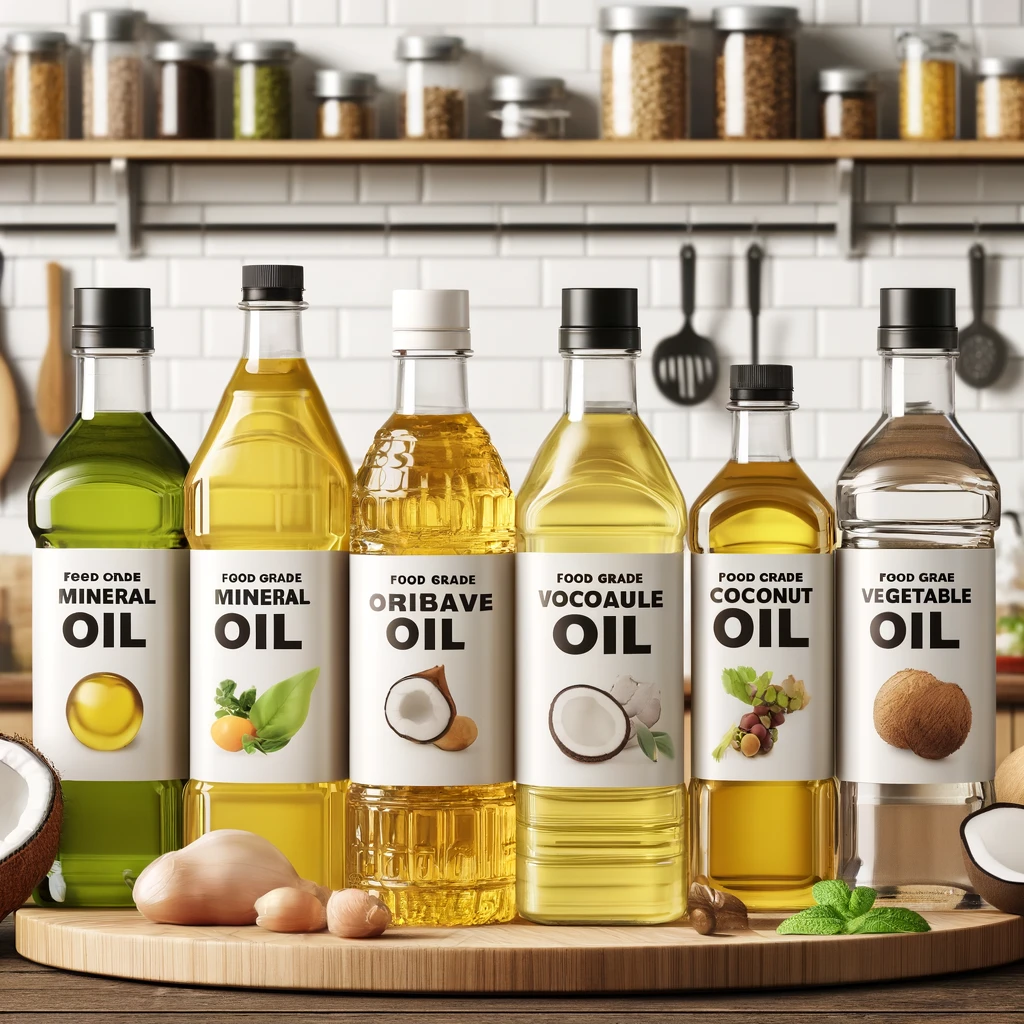
When it comes to maintaining the quality and longevity of your kitchen tools and surfaces, using the right type of oil is essential.
One such oil that is gaining popularity in the culinary world is food grade mineral oil. This versatile oil has a multitude of uses and benefits that make it a must-have in any kitchen.
In this article, we will explore the wonders of food grade mineral oil and why you should consider incorporating it into your kitchen routine.
Understanding Food Grade Mineral Oil
Food grade mineral oil is a clear, odorless, and tasteless product derived from petroleum.
Purification
It undergoes a rigorous purification process to ensure it is safe for use in applications that involve contact with food.
Refinement
This particular type of mineral oil is distinct from its non-food-grade counterparts due to its higher standards of refinement, which eliminate impurities and contaminants that could be harmful if ingested or applied to food-preparation surfaces.
Safety
Its safety for use in the kitchen and in products that come into direct contact with food is affirmed by the U.S. Food and Drug Administration (FDA), which classifies certain types of mineral oil as Generally Recognized as Safe (GRAS).
Classification
This classification is significant, as it places food grade mineral oil in a category of substances that are approved for their intended use and are not considered to pose a risk to health under the conditions of its intended use.
Due to its inert properties, food grade mineral oil does not spoil or turn rancid, a common problem with many plant-based oils.
Stability
This stability makes it an excellent choice for long-term use in the kitchen, particularly for the maintenance and preservation of wooden kitchenware and tools.
Its ability to remain stable and not oxidize or break down also means that it does not contribute unwanted flavors or odors to foods, maintaining the integrity of the culinary creations it comes into contact with.
Colorless
Additionally, its lack of color ensures that it does not stain or alter the appearance of the materials it is used on, making it ideal for maintaining the natural look of wood and other surfaces.
Versatility
The versatility and safety of food grade mineral oil, combined with its protective qualities, make it a valuable resource for anyone looking to preserve their kitchenware and enhance the functionality of their cooking space.
The Multifaceted Uses of Food Grade Mineral Oil
The versatility of food grade mineral oil extends far beyond the basic maintenance of kitchen tools and surfaces. Its wide array of applications makes it an invaluable addition to any culinary space.
Conditioner
Primarily, this oil serves as an excellent conditioner for wooden kitchen items such as cutting boards, butcher blocks, salad bowls, and utensils, preserving their beauty and functionality.
By applying food grade mineral oil to these items, you create a barrier that repels water and prevents the absorption of odors and stains, thereby extending the life of these essential kitchen tools.
Maintenance

Beyond wood care, food grade mineral oil plays a crucial role in the maintenance of stainless steel appliances and cookware.
Its application on stainless steel surfaces helps in preventing fingerprints and smudges, ensuring that these items retain their shine and aesthetic appeal.
This not only enhances the appearance of your kitchen but also contributes to the overall hygiene and cleanliness of the cooking environment.
Seasoning
In addition to wood and stainless steel care, food grade mineral oil is beneficial for seasoning cast iron cookware.
Applying a thin layer of this oil to cast iron pans and skillets forms a protective coat that prevents rust and ensures a non-stick surface, making it easier to cook and clean these items.
This treatment is essential for the preservation of cast iron cookware, which can last for generations if properly maintained.
Preparation
Furthermore, food grade mineral oil can be used in the preparation of kitchen countertops made from natural stones like granite or marble.
Its application provides a protective layer that enhances the stone’s resistance to stains and scratches, ensuring that countertops remain pristine and durable.
Its ability to protect, preserve, and enhance the appearance of various kitchen surfaces and tools makes it a staple in the culinary world.
With its safe and effective properties, food grade mineral oil ensures that your kitchen remains a place of beauty, hygiene, and efficiency.
Benefits of Using Food Grade Mineral Oil
Some of these are:
Safeguard
One significant benefit is its unparalleled ability to safeguard wooden kitchen implements and surfaces from damage due to moisture.
By forming a moisture-repellent barrier, it effectively prevents the penetration of water that could lead to the deterioration of wooden items through warping, splitting, or cracking.
This protective quality ensures the longevity and durability of your valuable kitchen assets, from cutting boards to butcher blocks.
Safety
Another advantage of food grade mineral oil is its safety profile. Its non-toxic nature makes it an ideal choice for use on surfaces that are in direct contact with food.
Unlike some oils that may pose health risks due to the presence of allergens or toxic components, food grade mineral oil offers peace of mind, knowing that it won’t introduce harmful substances into your food preparation areas.
This aspect is especially crucial in environments where food safety and hygiene are paramount.
Maintenance
Moreover, food grade mineral oil is an effective solution for maintaining the luster and functionality of various kitchen tools and surfaces.
Its application on stainless steel helps prevent corrosion and maintain the material’s shiny appearance, while its use on cast iron cookware aids in rust prevention and ensures a well-seasoned surface for non-stick cooking.
Resistance
Additionally, when applied to natural stone countertops, it enhances their resistance to stains and scratches, contributing to the overall upkeep of your kitchen’s aesthetic appeal.
Versatility
Food grade mineral oil’s versatility, coupled with its protective and safety attributes, underscores its indispensable role in kitchen maintenance.
By choosing to use this oil, you not only ensure the preservation of your kitchenware but also contribute to a safer, more efficient culinary environment.
How to Safely Apply Food Grade Mineral Oil
Applying food grade mineral oil to kitchen items such as cutting boards and wooden utensils requires attention to detail to ensure optimal protection and longevity of your tools.
Clean and Dry

To begin, ensure the wooden surface is clean and completely dry.
Any moisture on the surface can hinder the absorption of the oil. Use a clean, soft cloth or a brush specifically designed for oil application to apply the mineral oil.
Start Small
Start with a small amount, as a little goes a long way, and you can always add more if needed.
Gently Rub
Gently rub the oil into the wood in a circular motion, following the grain to allow for deeper penetration.
cover Entire Surface
Cover the entire surface evenly, not neglecting the edges and corners, as these areas are often the most susceptible to damage.
Apply on Both Sides
If you are treating a cutting board or butcher block, remember to apply oil to both sides to maintain balance and prevent warping.
Let it Soak
Once the oil is applied, let it soak into the wood for at least a few hours, or ideally overnight.
This resting period allows the oil to deeply penetrate the fibers of the wood, providing maximum protection and conditioning.
Wipe Off Excess
After the waiting period, take a clean, dry cloth and wipe off any excess oil that the wood did not absorb. This step is crucial to avoid a greasy residue on the surface of your wooden tools.
Apply Regularly
Regular application of food grade mineral oil, following these steps, will help maintain the integrity, beauty, and function of your wooden kitchen items.
For best results, treat your wooden tools with mineral oil once a month or whenever the wood starts to look dry and dull.
This routine care not only preserves your kitchenware but also ensures it remains safe and enjoyable to use for years to come.
Comparing Food Grade Mineral Oil to Other Oils

In the realm of kitchen care and maintenance, it’s imperative to understand how food grade mineral oil stands out compared to other types of oils.
This distinction is especially critical when it comes to the upkeep of wooden kitchen tools and surfaces.
Rancidity
Traditional oils, such as vegetable or nut-based oils, while natural, have a significant drawback: they can spoil and become rancid over time.
This rancidity not only imparts an unpleasant odor and taste to your kitchenware but can also attract bacteria, compromising the hygiene and safety of your food preparation environment.
Degradation
On the other hand, food grade mineral oil maintains its integrity and does not degrade in the same manner.
This longevity is due to its non-reactive nature, which ensures that it does not oxidize or break down when exposed to air.
Consequently, items treated with food grade mineral oil remain protected without the risk of developing rancid smells or flavors, thus contributing to their longevity and durability.
Allergic Reactions
Another factor to consider is the potential for allergic reactions.
With the increasing prevalence of food allergies, particularly to nuts and seeds, the choice of oil for kitchen maintenance becomes even more critical.
Food grade mineral oil poses no known allergen risk, making it a safe choice for households and professional settings where allergy concerns are paramount.
Practicality and Cost
Compared to specialty oils that are often marketed for the care of wooden kitchen items, food grade mineral oil offers a practical and cost-effective solution.
Specialty oils can come with a premium price tag and may contain a blend of ingredients, including essential oils or extracts, which do not provide any additional benefits in terms of protection and may even pose a risk of spoiling or causing allergic reactions.
In summary, food grade mineral oil’s stability, safety profile, and cost-effectiveness make it a superior choice for the maintenance of wooden kitchen tools and surfaces, setting it apart from other oil options in the market.
Understanding the Safety of Food Grade Mineral Oil
The conversation around the safety of using food grade mineral oil, especially in settings where it comes into contact with food, is crucial for both home cooks and professional chefs.
It’s essential to differentiate between the various types of mineral oil, as not all are created equal.
Stringent Safety Standards
Food grade mineral oil is specifically refined and purified to meet stringent safety standards set by regulatory agencies, including the FDA.
This ensures that it is devoid of harmful substances that could pose health risks, making it safe for use in the kitchen and on surfaces that come into contact with food.
Despite its petroleum-based origin, food grade mineral oil‘s safety profile is well-established.
It is designated as Generally Recognized as Safe (GRAS) by the FDA, an indication that it is considered safe for its intended use within the culinary industry.
This designation comes after thorough evaluation of the refining process and the oil’s intended applications, ensuring that it does not contain contaminants at levels that would cause harm when used in accordance with guidelines.
There are, however, guidelines on the use of food grade mineral oil that are important to follow.
It should be applied in a manner consistent with its labeling, ensuring that it is used as a surface treatment rather than as an ingredient in cooking.
Not Meant For Human Consumption
While it is recognized as safe for incidental food contact, it is not meant to be consumed in large quantities. Its primary role in the kitchen is as a protectant and conditioner for surfaces and tools.
Consumers should also be mindful of the quality and purity of the product they purchase.
Only mineral oil labeled as “food grade” should be used in any context where it might come into contact with food.
This distinction is critical, as not all mineral oil products on the market are intended or suitable for such use.
By adhering to these considerations, users can confidently incorporate food grade mineral oil into their kitchen practices without compromising safety.
Where to Purchase Quality Food Grade Mineral Oil

For those ready to add food grade mineral oil to their kitchen arsenal, sourcing a quality product is essential.
Kitchen specialty stores
The best place to start is at kitchen specialty stores, where knowledgeable staff can guide you towards high-quality, FDA-approved options.
These establishments often carry a selection of food grade mineral oils tailored for various kitchen applications, from conditioning wooden cutting boards to maintaining stainless steel surfaces.
Online Marketplaces
Online marketplaces are another convenient option, offering a wide array of brands and formulations of food grade mineral oil.
When shopping online, it’s crucial to read product descriptions carefully and check reviews to ensure the oil meets the necessary safety standards for use in food preparation areas.
Look for products specifically labeled as “food grade” and verify that the seller provides documentation or certification attesting to its safety and purity.
Pharmacies
Pharmacies and health food stores may also stock food grade mineral oil, typically in smaller quantities.
This can be a good option if you’re looking to trial the product before committing to a larger purchase. However, always confirm that the mineral oil is intended and safe for culinary use.
Manufacturers of wooden kitchen tools and accessories
Lastly, manufacturers of wooden kitchen tools and accessories sometimes sell their own branded food grade mineral oil, designed to complement their products.
Purchasing directly from these manufacturers can provide peace of mind, knowing that the oil is recommended for your specific kitchen items.
Regardless of where you choose to purchase, ensuring the mineral oil is labeled for food-grade use and adheres to FDA guidelines is paramount.
By selecting a reputable source, you can confidently integrate food grade mineral oil into your kitchen care routine, benefiting from its protective and enhancing qualities.
DIY Projects Using Food Grade Mineral Oil
Food grade mineral oil isn’t just for kitchen upkeep; its versatility shines through in numerous DIY projects that can enhance your home.
For those who love to craft or seek natural solutions for everyday problems, this oil provides an excellent base for homemade creations.
Wood Polish
Consider crafting your own wood polish using food grade mineral oil as a primary ingredient.
This natural polish can rejuvenate furniture, bringing out the beauty of the wood without the harsh chemicals found in commercial products.
Leather Conditioner
Another innovative use is creating a homemade leather conditioner.
Just as it moisturizes and protects wooden kitchen tools, food grade mineral oil can be applied to leather goods to help maintain their flexibility and prevent cracking, keeping your leather sofas, jackets, or boots in pristine condition for longer.
Rust Prevention
For a natural approach to rust prevention, mix food grade mineral oil with a little lemon juice and use it to coat metal tools and surfaces.
This mixture not only wards off rust but also leaves a pleasant, clean scent.
Shine up Leaves

Those with a green thumb can use food grade mineral oil to shine up the leaves of their hardy indoor plants, giving them a glossy finish while keeping dust at bay.
This method is particularly beneficial for plants with large leaves, where each leaf can be individually treated for a stunning natural sheen.
By exploring these DIY projects, you’re not just putting food grade mineral oil to good use outside the kitchen; you’re also tapping into sustainable, eco-friendly practices that benefit your home and the environment.
Related Articles:
All You Need to Know about Food Grade Buckets
Cut Through Grime: The Best Dishwasher Cleaner Review
As an Amazon Associate, I earn commission from qualifying purchases.




